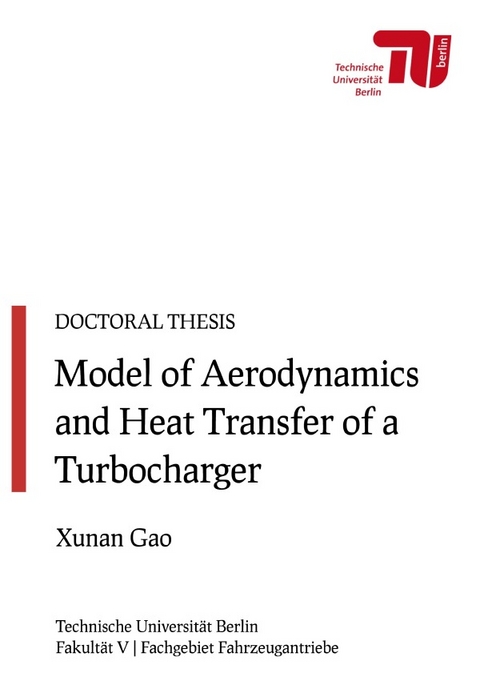
Model of Aerodynamics and Heat Transfer of a Turbocharger
Seiten
2019
epubli (Verlag)
978-3-7502-4815-1 (ISBN)
epubli (Verlag)
978-3-7502-4815-1 (ISBN)
- Titel leider nicht mehr lieferbar
- Artikel merken
This thesis focuses on the modeling of aerodynamics and heat transfer of a turbocharger for passenger cars. It aims to quantify the heat transfer of a turbocharger and to improve the 1D simulation.
This thesis deals with the modeling of aerodynamics and heat transfer of a turbocharger for passenger cars. It aims to quantify the heat transfer of a turbocharger and to improve the 1D simulation by considering the effects of heat transfer.
The first part involves a measurement study of a turbocharger on a hot gas test bench under both adiabatic and diabatic conditions to obtain the turbocharger aerodynamic characterizations as well as the heat transfer behavior under different thermal conditions.
In the second part, a numerical analysis of heat transfer is carried out by using conjugate heat transfer (CHT) simulation for the turbine and compressor, respectively. With respect to the turbine CHT simulation, a new approach (i.e., combined-CHT) is proposed to improve the resolution of the external convection while maintaining the computational cost. The combined-CHT simulation is shown to offer reliable modeling of the turbine heat transfer with a computational cost comparable to that of the ordinary single-CHT simulation. As for the compressor CHT simulation, an analysis of the influence of heat transfer on the characterization process is carried out. The measured compressor efficiency is observed to be up to 15 percent lower than its actual value under these conditions.
In the third part, a new 1D/3D-FEM (Finite Element Method) model is developed for the turbocharger, combining the 1D model for the flow field and 3D FEM model for the turbine housing and compressor housing. It aims to consider the heat transfer in a 1D simulation, which is usually employed for the engine simulation. The estimated turbo speeds and compressor outlet temperatures from the two models are comparable, while the 1D/3D-FEM model is shown to greatly reduce the error of the estimated turbine outlet temperatures. Furthermore, the 1D/3D-FEM model is expected to be applicable to turbochargers with a variety of configurations in different operating scenarios.
This thesis deals with the modeling of aerodynamics and heat transfer of a turbocharger for passenger cars. It aims to quantify the heat transfer of a turbocharger and to improve the 1D simulation by considering the effects of heat transfer.
The first part involves a measurement study of a turbocharger on a hot gas test bench under both adiabatic and diabatic conditions to obtain the turbocharger aerodynamic characterizations as well as the heat transfer behavior under different thermal conditions.
In the second part, a numerical analysis of heat transfer is carried out by using conjugate heat transfer (CHT) simulation for the turbine and compressor, respectively. With respect to the turbine CHT simulation, a new approach (i.e., combined-CHT) is proposed to improve the resolution of the external convection while maintaining the computational cost. The combined-CHT simulation is shown to offer reliable modeling of the turbine heat transfer with a computational cost comparable to that of the ordinary single-CHT simulation. As for the compressor CHT simulation, an analysis of the influence of heat transfer on the characterization process is carried out. The measured compressor efficiency is observed to be up to 15 percent lower than its actual value under these conditions.
In the third part, a new 1D/3D-FEM (Finite Element Method) model is developed for the turbocharger, combining the 1D model for the flow field and 3D FEM model for the turbine housing and compressor housing. It aims to consider the heat transfer in a 1D simulation, which is usually employed for the engine simulation. The estimated turbo speeds and compressor outlet temperatures from the two models are comparable, while the 1D/3D-FEM model is shown to greatly reduce the error of the estimated turbine outlet temperatures. Furthermore, the 1D/3D-FEM model is expected to be applicable to turbochargers with a variety of configurations in different operating scenarios.
Xunan Gao has been a Ph.D. candidate in the Chair of Powertrain Technologies at the Technische Universität Berlin since September 2015. Before that, he received the M.Sc. degree in Power Machinery and Engineering from Tongji University after receiving the B.Sc. degree in Heat Energy and Power Engineering from Hefei University of Technology. His current research interests include turbocharging, heat transfer, computational fluid dynamics and engine simulation.
| Erscheinungsdatum | 01.11.2019 |
|---|---|
| Sprache | englisch |
| Maße | 148 x 210 mm |
| Gewicht | 283 g |
| Themenwelt | Sachbuch/Ratgeber ► Natur / Technik ► Technik |
| Technik ► Fahrzeugbau / Schiffbau | |
| Schlagworte | Compressor • Conjugate Heat Transfer • heat transfer • Turbine • turbocharger |
| ISBN-10 | 3-7502-4815-X / 375024815X |
| ISBN-13 | 978-3-7502-4815-1 / 9783750248151 |
| Zustand | Neuware |
| Haben Sie eine Frage zum Produkt? |
Mehr entdecken
aus dem Bereich
aus dem Bereich
die wichtigsten Begriffe, Bautypen und Bauelemente
Buch | Softcover (2024)
Prestel (Verlag)
CHF 44,75
Buch | Hardcover (2021)
C. Bertelsmann (Verlag)
CHF 25,20
vom Kolosseum über die Akropolis bis zur Alhambra
Buch | Hardcover (2023)
DK (Verlag)
CHF 29,90


